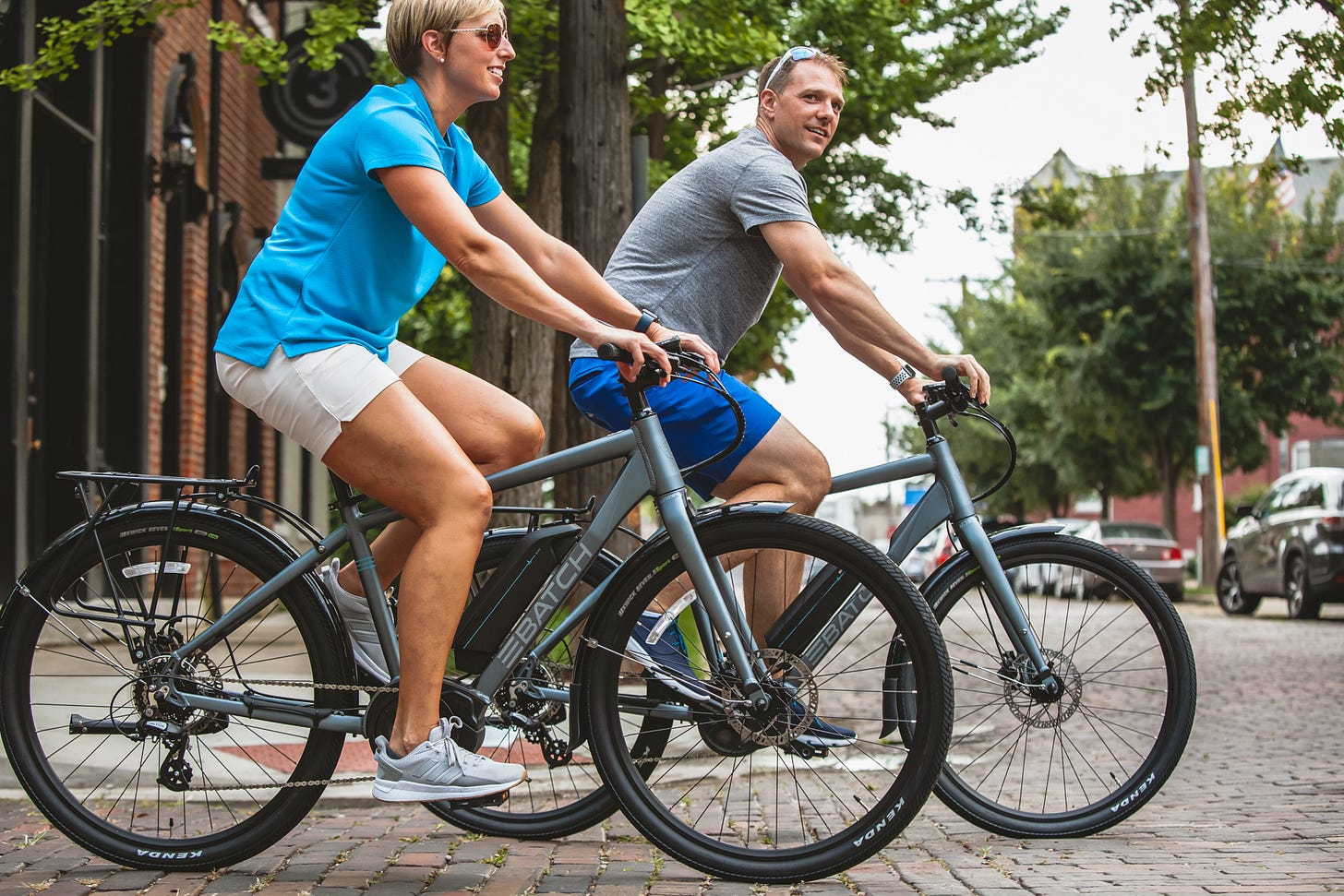“I Love it!” The person who has identified herself as Jackie is locking her e-bike up to a bike stand in front one of the bars in my neighborhood. There is a slight click! as the lock secures. Jackie smiles and pats the bicycle seat. “I’m saving all kinds of money on gasoline. I’m thinking of selling my car.”
Jackie is not alone Every person I talk to who has bought an e-bike raves about them. I know folks who haven’t gotten on a bicycle since they were children. Now they brag to me as to how often they run errands, commute, or just tour around their neighborhoods on their new electric bicycles.
Judging from the number of e-cyclists I see pass in front of my apartment, there are a lot of other folks in my neighborhood who have caught the e-bike bug. I live on a fairly busy street. Before the pandemic, I don’t think I can recall seeing one pass by. Now, I’ll see anywhere from a half dozen to more than a score pass in an hour
.
While it might be easy to dismiss them as a fad, that they are merely an updated, electronic version of the moped (The motorcycle/bicycle hybrids were somewhat common 40 years ago, but has anybody seen one recently?), e-bikes are certainly having their moment now. Much of that might be attributed to the pandemic, when people were desperate to get outdoors and do any sort of activity. Sales of e-bikes went up 145 percent during the height of the pandemic in the summer of 2020, outselling electric cars two-to-one. According to Research and Markets, the global market for electric bikes in 2021 was valued at $45.75 billion and predicted to reach $109.53 billion by 2030.
There has been some push-back. E-bike cyclists are traveling routes that have been the domain of bicycles, but doing so at 30 miles-an-hour, which can surprise and scare pedestrians. In response, states and municipalities are starting to pass laws and codes, such as requiring licensing and insurance for e-bikes. In 2017, Boise, Idaho established a speed limit of 20 mph on electric bicycles. In 2018, Tucson established a similar ordinance.
E-bikes are good for the environment and good for you, too
An electric bike causes a small fraction of the greenhouse gases that a gasoline powered automobile does, and if it is charged from renewable energy, its environmental costs are almost nil. A recent study that looked at e-bike use in Portland, Oregon found that replacing just 15 percent of car trips with e-bike rides would lower greenhouse gas emissions by 12 percent.
Electronic bikes may also have additional health and safety benefits. A study published in the journal Environmental Health Perspectives estimates that premature deaths can be reduced if bicycles and e-bikes wind up replacing urban car trips. Researchers looked at 17 countries from all over the world, including Russia, South Africa, Brazil, and Canada. The results are quite mixed and interesting. Replacing driving with cycling will result in more deaths from air pollution, because people breathe deeper and faster when they peddle their bicycles. Bicycle crashes will also lead to more deaths than car crashes.
What the researchers found, however, is that the health benefits from increased cardiovascular activity, which fights heart disease, diabetes, and other ailments. would far outweigh the deaths from pollution and crashes. And it is possible to bring the number of deaths from crashes down. A study in China found that most e-bike fatalities are from people doing really stupid things, like driving in lanes reserved for cars, running through red lights, riding their bikes against the direction of traffic, and getting on their electric two-wheeler when they have had one too many. Perhaps a licensing of e-bikers and e-bike rider education could bring down the number of fatalities. One of the findings of the paper, that most nighttime e-bike fatalities happened because of bad street lighting, could be remedied by more effective lighting.
Environmental costs of e-bike batteries
E-bikes rely on lithium batteries, the same kind of batteries that hold the charge for electric cars and hybrids. For their weight and size, lithium batteries can hold a large charge, making them the most suitable type of battery for cars and bikes.
Lithium is mined in an unusual way. It doesn’t exist as an ore, like iron or copper. Rather, it is usually found existing in a briny solution at the bottom of underground water sources. Mining it, which is basically pumping the brine up and separating the lithium from the water, can disturb aquifers and even disrupt ecosystems. Some communities where lithium mines are proposed are pushing back, saying the environmental damage is too great to sustain. I know of at least one case in which a lithium mine threatens the existence of a rare buckwheat. The Tiehm’s buckwheat, which has a very limited habitat, is currently being reviewed by the US Fish and Wildlife Service to see if it merits listing as an endangered species. The Australian company that wants to build the lithium mine in Nevada has assured regulators and the public that the techniques they plan on employing will leave the buckwheat alone.
Bike enthusiasts could justifiably claim that the lithium used to charge e-bikes is a fraction of what is used by Teslas and Priuses, so the effects of their lithium use is far less. There are also programs popping up to recycle batteries from electric bicycles.
News of the week
In Mountain State Spotlight, a nonprofit news organization that focuses on West Virginia, Ken Ward, along with Alexa Beyer report on one of the provisions that Senator Joe Manchin was able to get included into the Inflation Reduction Act, the first major global heating legislation from the federal government.
Manchin was able to get wording into the bill that would clear the way for the Mountain Valley Pipeline, a planned 303 mile long natural gas pipeline that will connect northeastern West Virginia with Virginia. The pipeline has been held up past its planned 2018 completion date, due to environmental concerns and flaws in the project’s permit applications.
For more environmental science & news follow me on Twitter @EcoScripsit.





